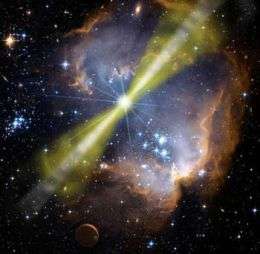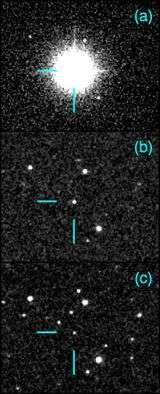'Naked Eye' Gamma Ray Burst Was Aimed Squarely At Earth

(PhysOrg.com) -- The brightest explosion ever seen was observed in March this year. Now a team of astronomers from around the world, including the University of Leicester, the Mullard Space Science Laboratory of University College London and Liverpool John Moores University, have combined their data from satellites and observatories to explain what happened.
They show that the jet from a powerful stellar explosion in a galaxy halfway across the Universe was aimed almost directly at Earth. The event, called a Gamma-Ray Burst (GRB), was bright enough for human eyes to see.

GRBs are the Universe's most luminous explosions. Early in the morning of March 19, the Swift satellite, a joint NASA/UK/Italian mission, pinpointed an extremely bright GRB and immediately sent out an alert to observatories around the world. Two robotic wide-field optical cameras in Chile also observed the brief flash: "Pi of the Sky," which is operated by the Centre for Theoretical Physics in Warsaw, Poland, and TORTORA, based at ESO’s La Silla Observatory. TORTORA is operated by a Russian-Italian collaboration. Within minutes many more telescopes were observing, allowing for the most detailed study of a bright GRB ever undertaken using data from gamma-ray to radio wavelengths.
A team of astronomers led by Judith Racusin of Penn State University, present their findings in a paper to appear in the September 10 issue of the journal Nature, following work first presented at the May meeting of the Royal Astronomical Society. The team conclude that the extraordinary brightness of the March 19 burst arose from a narrow jet that shot material directly toward Earth at 99.99995 percent of the speed of light. The data clearly reveal the complexity of a GRB in which a narrow, ultra-fast jet is present within a wider, slightly slower jet.
Dr. Paul O’Brien of the University of Leicester, part of the Swift team, said “We normally detect only the wide jet of a GRB as the inner jet is very narrow, equivalent to not much more than 1/100th the angular size of the full Moon. It seems that to see a very bright GRB the narrow jet has to be pointing precisely at the Earth. We would expect that to happen only about once per decade. On March 19th, we got lucky.”
Dr. Patricia Schady of the Mullard Space Science Laboratory, also part of the Swift team, commented “The GRB was created when a massive star ran out of nuclear fuel. The star's core collapsed to form a black hole, driving powerful jets outward. These jets are amongst the fastest bulk flow of matter in the cosmos, moving close to the speed of light.”
By rapidly coordinating their efforts using data sent over the Internet, astronomers were able to ensure they made the best possible use of all available British and international telescopes to observe this extraordinarily bright event. Among the telescopes which responded to the alert from Swift was the UK’s largest robotic telescope, the Liverpool Telescope, located on the island of La Palma. Dr Robert Smith from the Liverpool John Moores University, which operates the telescope, said “As the GRB jets move outwards they strike gas previously shed by the star and heat it. This generates emission called the ‘afterglow’. The Liverpool Telescope and other telescopes detected this emission which confirmed the width of the jets.”
Dr. Jonathan Granot from the University of Hertfordshire, lead theorist on the paper, explained “What really makes this GRB unique is its extremely bright prompt optical emission (visible with the naked-eye), which coincides in time with the gamma-rays, and was recorded with amazing time resolution. The optical and gamma-rays are in distinct spectral components, produced by a different emission mechanisms, but most likely came from the same physical region, far from the progenitor star.”
Video of the first presentation of the work at the Royal Astronomical Society by Leicester University Research Associate Dr. Rhaana Starling
clients.mediaondemand.net/ras/ … =externalRas123&id=3
Provided by Royal Astronomical Society




















